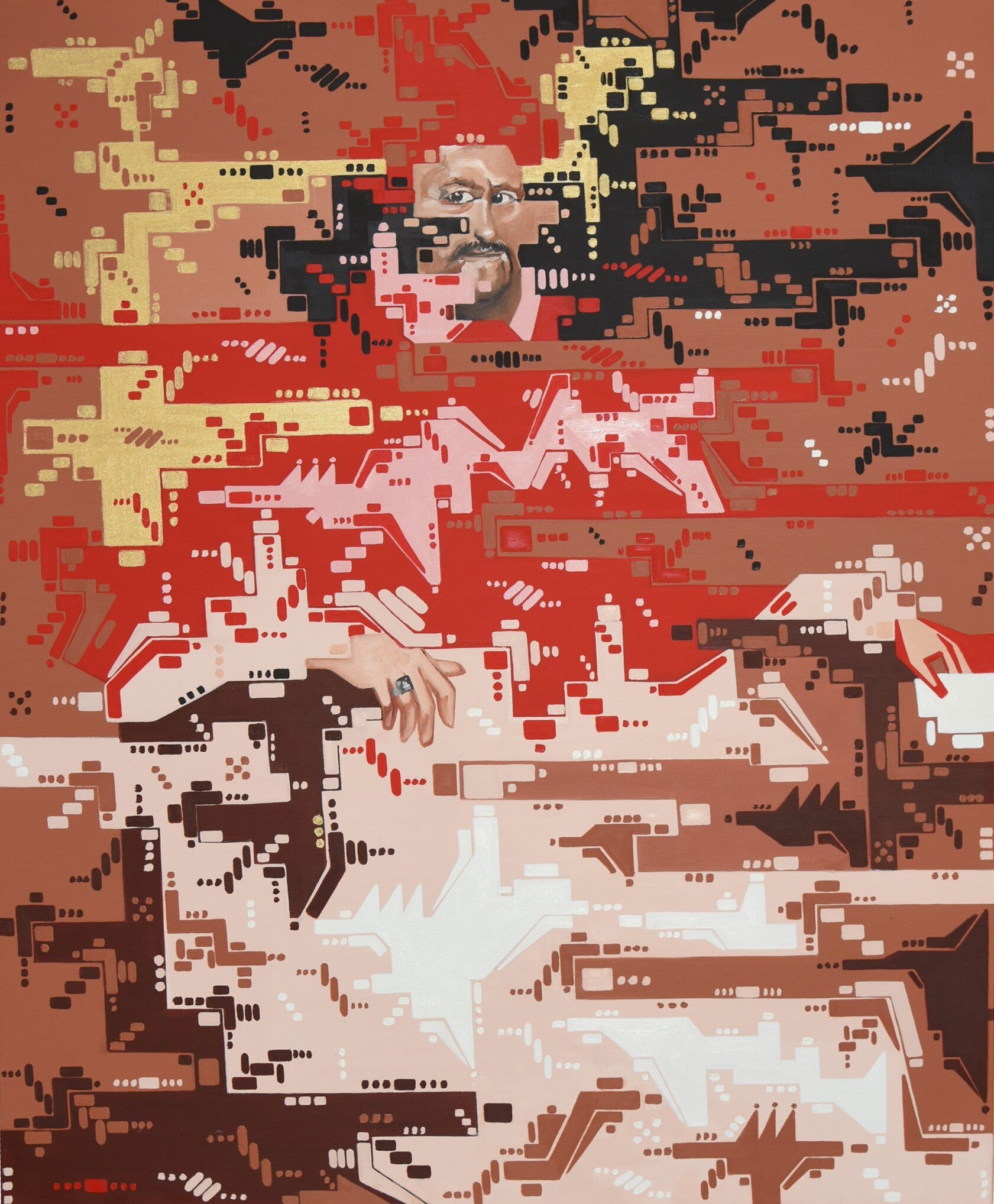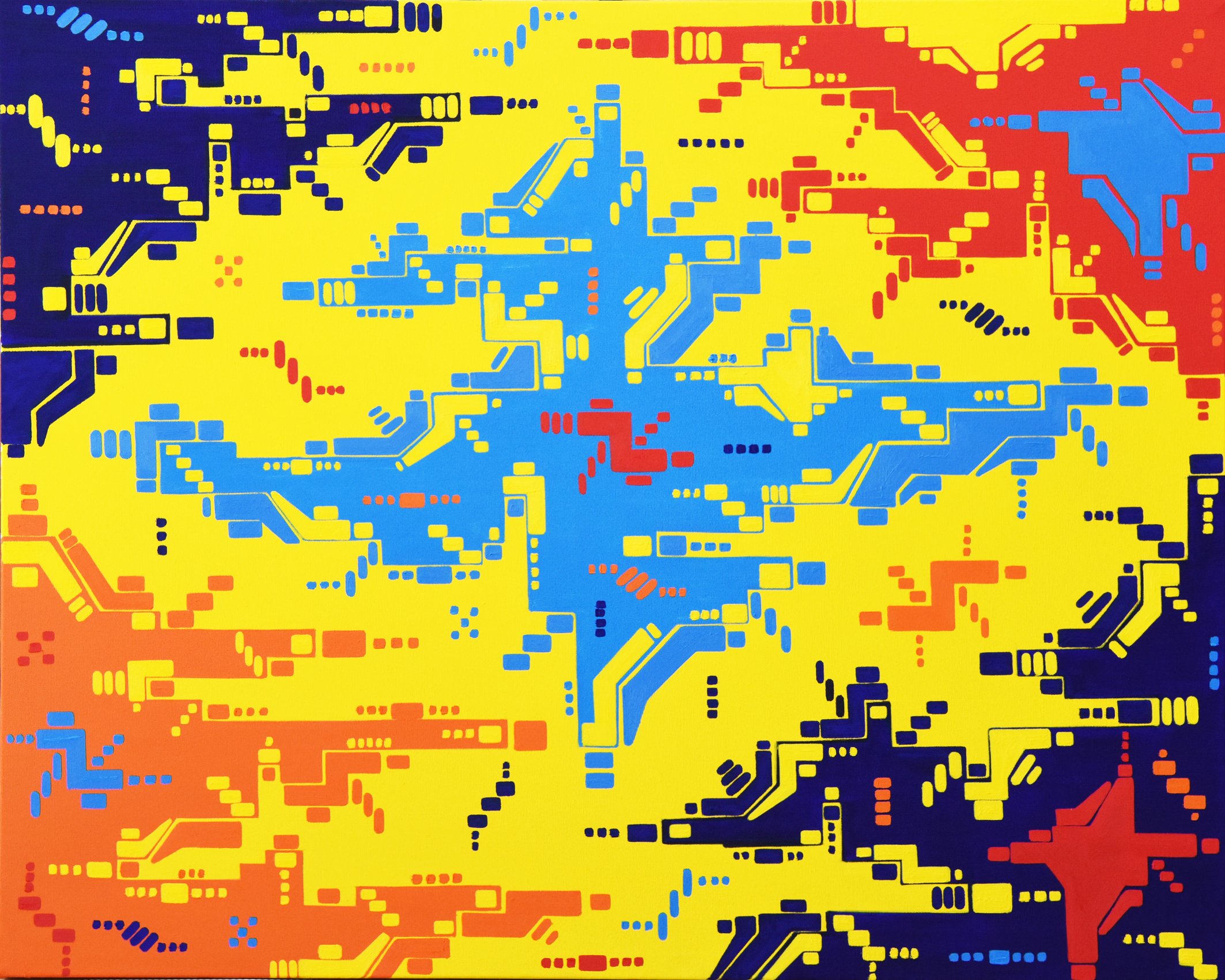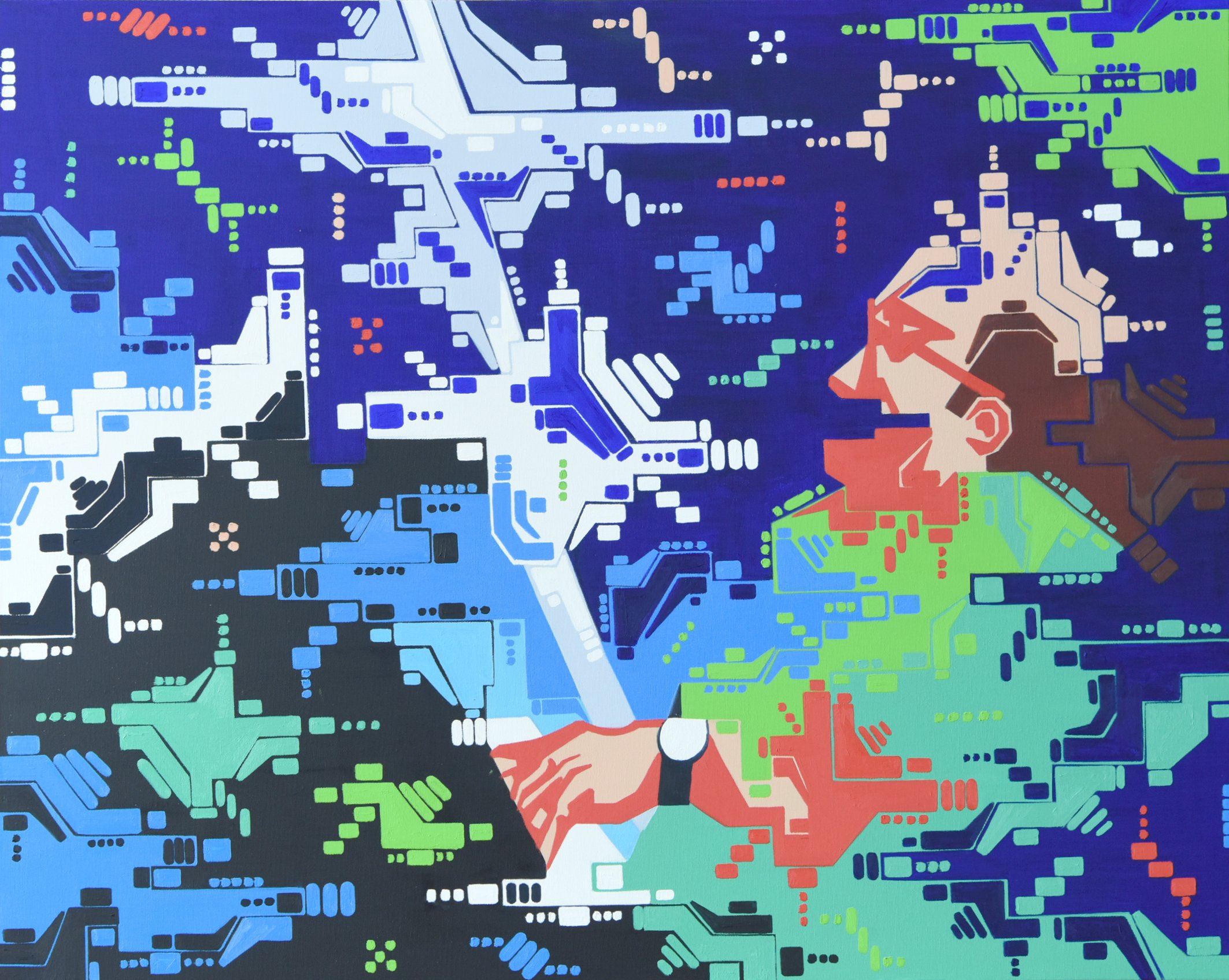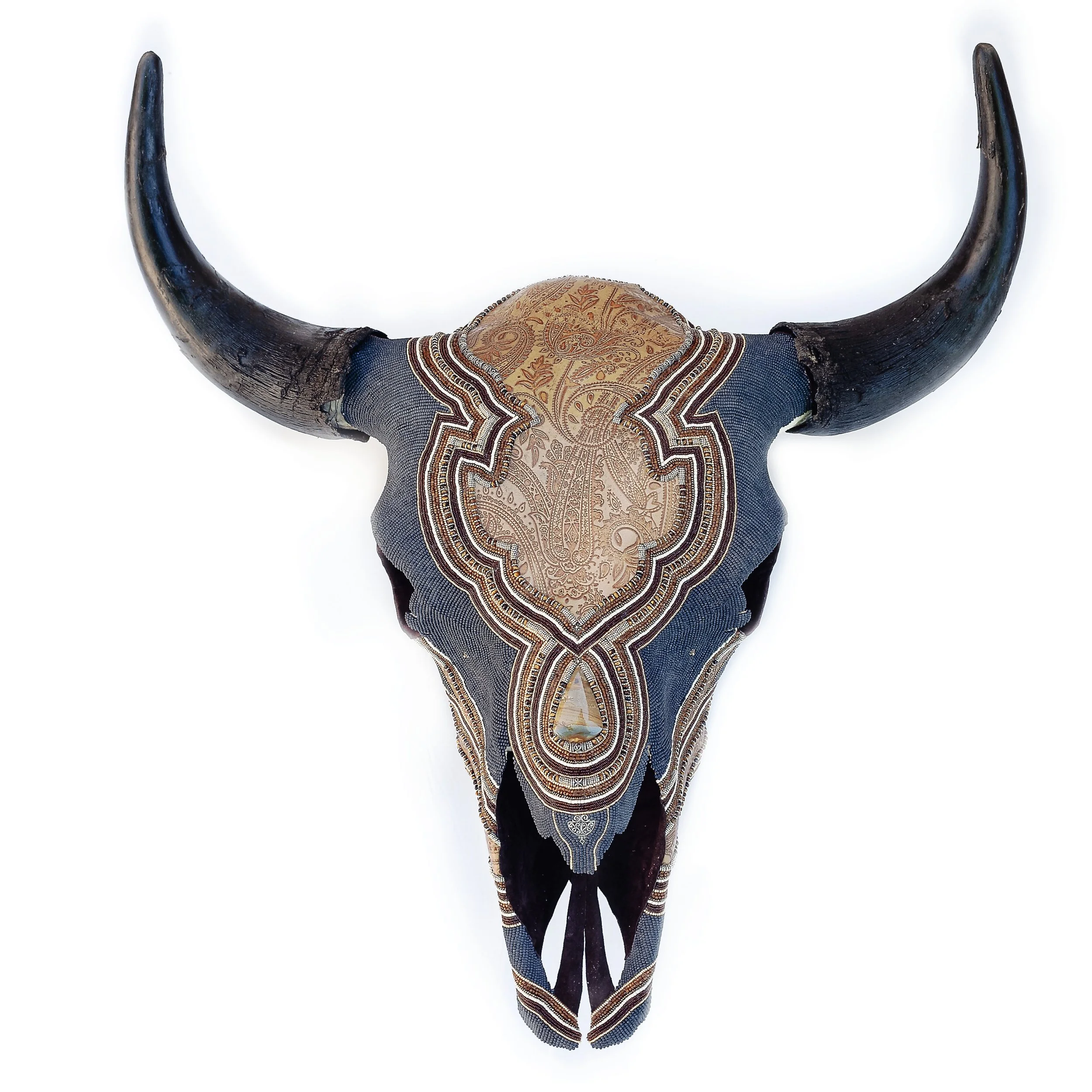Aurelio Gaiga
Aurelio Gaiga
Aurelio Gaiga's latest painting collection, as evidenced by the provided artworks, embodies a profound and timely commentary on the intersection of humanity with burgeoning technology. The series, initiated in 2018, appears to dissect and examine the omnipresent role of technology in contemporary life and its implications for our collective memory, cultural heritage, and individual identities.
Gaiga's paintings emerge as a potent fusion of traditional portraiture and a pixelated, almost digital disruption that mimics television static or image corruption. By deliberately dematerializing his subjects—people engaged in everyday activities such as reading a newspaper or enjoying a coffee—the artist challenges the viewer's perception and questions the very essence of reality as we transition more into a digital epoch. This visual manipulation resonates deeply, prompting reflections on how the digital age could be reshaping our personal experiences and societal interactions.
The use of vivid and intense colors is particularly striking, introducing a dichotomy between the seductive veneer of technology and its potentially darker, unexplored ramifications. Gaiga's choice to accentuate the positive, alluring aspects of each new technological advancement, while leaving the negative connotations unaddressed, plays into the broader societal tendency to adopt new technologies without fully considering their long-term impacts.
Aurelio Gaiga's art is a visual treatise on the philosophy of technology, a field that scrutinizes the nature, origins, and impacts of technology on human life and society. His paintings act as a canvas for philosophical inquiry, probing deep into the ontological and existential changes brought about by the digital age. Through the lens of philosophy, Gaiga's work resonates with the ideas of thinkers like Martin Heidegger, who was concerned with technology's ability to shape and define our world, potentially leading to a forgetfulness of being.
In Heidegger's view, technology is not merely a collection of tools; it is a way of understanding the world that can obscure our fundamental relationship with reality. Gaiga's distorted, pixelated figures and scenes embody this concept, visualizing the risk of a digital veneer overwriting our authentic experiences. The vivid colors and fragmentation serve as a metaphor for the vibrant allure of technology, juxtaposed with the potential loss of human essence and history—mirroring Heidegger's warning of technology's capacity to distance us from the true nature of things.
Gaiga's reinterpretations of historical artworks in the digital idiom invite parallels to the philosophy of Walter Benjamin, who discussed the 'aura' of artworks and how their reproduction in the modern age affects their reception and meaning. Gaiga's art, by digitizing and distorting these iconic images, raises questions about the 'aura' in the digital age—whether it can survive the transition and what new forms of appreciation and understanding can arise.
The important message that Gaiga brings through his art is multifaceted: it is a cautionary tale of technology's seductive power and its ability to redefine our perception of reality. His works serve as a philosophical commentary on the potential for technology to disrupt and dissolve the historical and cultural continuity that defines humanity. They urge us to consider how technology should serve to enhance human life without supplanting the rich textures of lived experience and memory. Thus, Gaiga's art stands as a contemporary philosophical herald, echoing the timeless inquiry into the nature of human existence in a world increasingly mediated by technology.
Comparatively, if one were to juxtapose Gaiga's art with that of a classical painter, such as Johannes Vermeer—known for his meticulous attention to the subtleties of light and color—Gaiga's work can be seen as a futuristic iteration. Where Vermeer captured the quiet moments of domestic life with gentle realism, Gaiga catapults these moments into the digital age, suggesting a new type of intimacy shaped by the pervasive influence of technology.
Gaiga's contribution to the contemporary art scene is significant in its immediacy and relevance. At a time when digitalization is at the forefront of societal evolution, his works provide a contemplative space to question and explore the implications of this transition. His art does not just reflect on the individual subject but rather expands the narrative to engage with a broader societal dialogue about technology's role in shaping collective memory, culture, and identity.
The importance of Gaiga's art lies in its ability to serve as a historical document of the present, capturing the zeitgeist of a world in the throes of digital transformation. His works teach us to look beyond the surface, to see the interplay of past and present, and to critically assess the path we are traversing as a society deeply entangled with technology.
His collection, ultimately, delivers a message urging vigilance. It serves as a reminder that while technology holds the promise of progress, it also has the power to alter our perceptions and potentially erase the nuances of human experience. Gaiga, through his art, ensures that these critical conversations are not only reserved for technological forums but are also expressed and examined within the visual language of contemporary art.
Aurelio Gaiga, with this body of work, secures his place as an essential voice in the contemporary art scene. Through his unique visual syntax, he reminds us of the persistent and dynamic relationship between art and life, encouraging a nuanced understanding of the world as we navigate through the digital age.
Aurelio Gaiga’s art teaches us to critically engage with the world as it becomes increasingly digitized. By reimagining everyday moments and iconic works of art through a lens that distorts and pixelates, Gaiga’s paintings prompt viewers to consider how technology changes the way we perceive reality.
His work highlights the double-edged sword of technology: it can both enhance and obscure our experience of life. On one hand, the bright, bold colors and patterns reflect the attractive, almost hypnotic appeal of new tech; on the other, the disruption of familiar images warns of how these advancements can interfere with our connection to the past and to one another. This visual metaphor teaches us that technology, while transformative and beneficial in many ways, also has the power to detach us from the tactile, organic aspects of human existence.
Gaiga's art educates us about the importance of maintaining a balance between embracing the benefits of technological progress and preserving the integrity of our cultural and historical identity. The dematerialization of figures and scenes acts as a cautionary symbol for the potential dematerialization of our humanity if we let technology dominate without mindful consideration.
Gaiga’s reinterpretations of classic paintings are instructive in how they suggest that our cultural heritage may be vulnerable to the homogenizing effects of digital manipulation. They remind us that while technology can be a tool for preservation, it can also be an agent of change—sometimes radical, sometimes subtle—that can alter the very essence of our art, history, and narratives.
His art imparts the lesson that in a world where technology’s presence is all-encompassing, it is imperative to foster a dialogue about its role and impact. Gaiga encourages us to reflect on the ways in which we let technology shape our lives and to actively choose the parts of our humanity that we should hold dear and preserve for future generations.
Aurelio Gaiga's art is an essential mirror held up to the zeitgeist of the digital era, reflecting the profound and rapid transformations technology imposes upon society, culture, and individual identity. His canvases act as a visual lexicon for the digital age, interpreting and questioning the pervasiveness of technology in our daily lives. Gaiga's work is a poignant reminder that while we are passengers on the train of technological progress, we must also be its conductors, ensuring that our journey does not stray from the tracks of our shared human essence.
The message Gaiga imparts through his art is not a simple warning but a complex conversation between the past, present, and future. He invites the viewer to partake in a dialogue on the impermanence of the human experience in a world increasingly defined by bytes and pixels. His vivid and intense use of color emphasizes the allure of technological advances while also urging a contemplation of what might be obscured or lost amidst their glow.
In the contemporary art scene, Aurelio Gaiga has carved out a unique niche. He stands at the confluence of traditional fine art and modern digital commentary, a bridge between the tangible textures of the old masters and the abstracted visions of the future. Gaiga's work is highly relevant, not only for its aesthetic appeal but for its cultural and philosophical resonance in an age where the lines between human and technology are ever-blurring.
Gaiga's placement is among those contemporary artists who are recognized not just for their skill and vision but for their ability to engage with timely, existential themes that resonate on a global scale. His works serve as cultural artifacts of the present, destined to be referenced and reflected upon as society continues to navigate the complexities of the digital landscape.
As the art world continues to expand its boundaries to include new mediums and methods of expression, Gaiga's paintings are likely to be celebrated for their innovative approach to traditional subjects. His voice contributes significantly to the narrative of contemporary art, addressing some of the most pressing concerns of our time with both subtlety and power. Gaiga’s work is, indeed, a vibrant testament to the enduring role of art in exploring and challenging the human condition.
By Marta Puig
Editor Contemporary Art Curator Magazine










